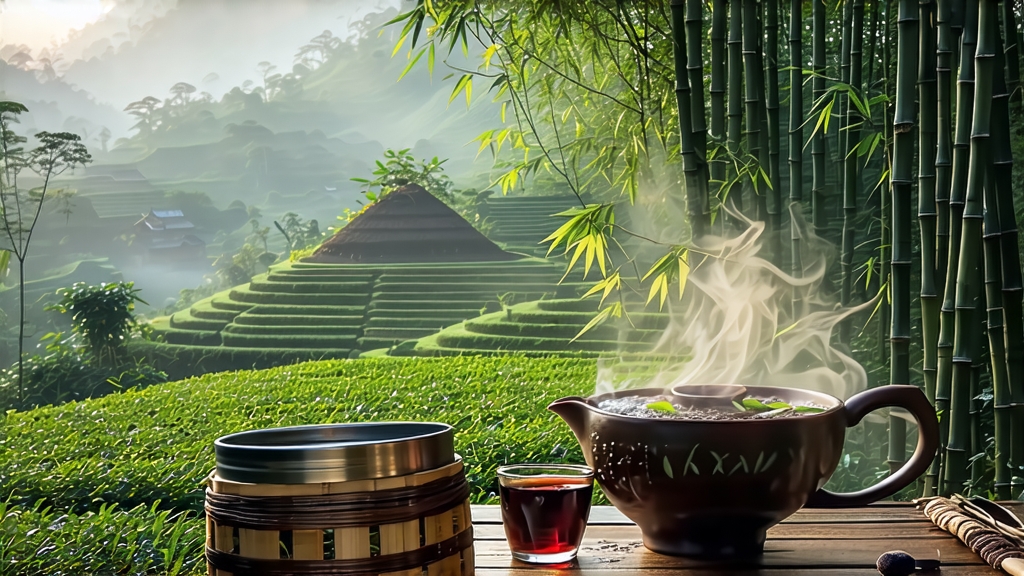
Tucked away in the humid, karst-pocked mountains of southern China’s Guangxi Zhuang Autonomous Region, Liupao tea (often spelled Liu Bao) is the quiet genius of the dark-tea family. While Pu-erh hoards the international spotlight, Liupao has spent four centuries perfecting a deeper, subtler alchemy of microbes, humidity, and time. To the uninitiated it is merely another brick of inky leaves; to the initiated it is liquid history, a tea that once walked the Tea-Horse Road southward into Malaysia and Singapore, curing miners of damp-induced rheumatism and earning the nickname “cooling tea” in tropical dialects.
The story begins during the late Ming dynasty, when merchants in the township of Liupao, Cangwu County, found that tea shipped down the Xun River to Guangzhou and onward to Southeast Asia arrived darker, smoother, and suddenly medicinal. The six to eight weeks spent in the dank holds of junks acted as an accidental second fermentation, softening the rough green leaves harvested from local medium-leaf cultivars. By the Qing’s Qianlong reign (1736-1795), Liupao was listed among the “24 famous teas” presented to the emperor, and imperial tax records show it being traded for Malay tin and pepper.
Unlike Pu-erh, whose fame is split between raw (sheng) and ripe (shou) styles, Liupao is almost always post-fermented, but the technique is unique. After the classic steps of plucking, withering, fixing in a huge wok at 160 °C to kill green enzymes, and rolling to bruise the leaf cells, the leaves are piled while still warm into wicker baskets lined with banana leaf. Here begins the critical “wet piling” (wo dui) phase, predating Pu-erh’s invention of the same process by at least two centuries. Workers spray a calculated mist of mineral-rich spring water, cover the heap with jute sacks, and allow thermophilic fungi such as Aspergillus niger and yeasts like Cyberlindnera to bloom. Temperature is monitored by inserting a bare forearm into the pile; when the heat becomes uncomfortable after five seconds, it is time to turn the leaves. Over 25-35 days the leaf color shifts from olive to umber to obsidian, while a mellow earthiness rises, tinged with the unmistakable scent of betel nut—an aroma that will later translate into the cup.
The final twist is the “basket aging.” Semi-dry leaves are packed tightly into 40 kg rattan baskets woven in the villages of Liupao and Shuangqian. These baskets breathe; over months and years they allow a slow exchange of mountain air, bamboo tannin, and residual moisture. A 2019 study at the Chinese Academy of Agricultural Sciences found that the specific porosity of Liupao baskets encourages a secondary microbial consortium dominated by Eurotium cristatum—the same “golden flower” prized in Hunan’s Fu brick. The result is a tea that can improve for decades, growing sweeter, rounder, and more resonant.
Modern Liupao is classified by vintage, leaf grade, and basket size. “San He” brand, founded 1954, still stamps each basket with a red chop that collectors treat like a Cognac vintage. Top grades use one bud with two leaves picked before Qingming; lower grades incorporate third- and fourth-leaf material that brings more tannin and a darker liquor. Compressed forms—mini bricks, 250 g coins, 1 kg logs—are recent innovations aimed at urban storage, yet purists insist the classic 40 kg basket breathes best.
To brew Liupao well, treat it like a Burgundy rather than a Bordeaux: coax, don’t bully. Start with 5 g for a 120 ml gaiwan or 8 g for a 180 ml Yixing pot. Rinse once with water just off the boil, then steep 10 s, 15 s, 20 s, adding five seconds each infusion. The first pour releases a deep garnet liquor, clear at the rim, almost black at the core. Aroma rises in layers: damp sweet bark, dried longan, a whiff of camphor from the baskets. On the palate it is immediately sweet, reminiscent of Chinese red dates, then slides into a cool, mentholated finish that lingers